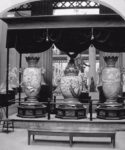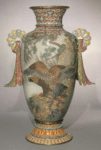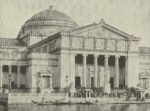 A monumental Japanese cloisonné vase that represented in spectacular form the art of its country at the 1893 Columbian Exposition in Chicago was recently rediscovered after hiding in glaringly plain sight for a century and sold at auction on Sunday. The masterpiece of porcelain, enamel and woodwork 8’8″ high went to a private buyer in New York for $135,000 hammer price, almost five times the high estimate of $50,000.
A monumental Japanese cloisonné vase that represented in spectacular form the art of its country at the 1893 Columbian Exposition in Chicago was recently rediscovered after hiding in glaringly plain sight for a century and sold at auction on Sunday. The masterpiece of porcelain, enamel and woodwork 8’8″ high went to a private buyer in New York for $135,000 hammer price, almost five times the high estimate of $50,000.
The vases were the largest examples of cloisonné enamel ever made up until that time, and they  had a large statement to make at the Chicago World’s Fair. Placed in a group under a canopy in the East Court of the Palace of Fine Arts under a canopy were three exceptional pieces, the work of Japan’s greatest masters: two monumental vases and an incense burner. The combined effort of metalworkers, potters, wood carvers and painters, they were designed especially for the Exposition and took four years to make and decorate. Before they were shipped to Chicago, they were viewed and approved by the Emperor and Empress of Japan.
had a large statement to make at the Chicago World’s Fair. Placed in a group under a canopy in the East Court of the Palace of Fine Arts under a canopy were three exceptional pieces, the work of Japan’s greatest masters: two monumental vases and an incense burner. The combined effort of metalworkers, potters, wood carvers and painters, they were designed especially for the Exposition and took four years to make and decorate. Before they were shipped to Chicago, they were viewed and approved by the Emperor and Empress of Japan.
 The designs on the vases and incense burner were conceived by Shin Shiwoda, Special Counsellor for Arts of the Japanese Commission to the Exposition. The ostensible motif is the seasons of the years: chickens symbolize spring, dragon summer, eagles autumn and winter. A full moon and flight of plover on the back of the dragon vase symbolize summer and fall. The birds under a snow laden branch on the back of the eagle vase represent winter. A cherry tree in blossom on the censer represents spring. The dragon, chickens and eagles also symbolize the three virtues of, respectively, wisdom, honesty and strength.
The designs on the vases and incense burner were conceived by Shin Shiwoda, Special Counsellor for Arts of the Japanese Commission to the Exposition. The ostensible motif is the seasons of the years: chickens symbolize spring, dragon summer, eagles autumn and winter. A full moon and flight of plover on the back of the dragon vase symbolize summer and fall. The birds under a snow laden branch on the back of the eagle vase represent winter. A cherry tree in blossom on the censer represents spring. The dragon, chickens and eagles also symbolize the three virtues of, respectively, wisdom, honesty and strength.
The vases and censer were placed on pedestals of carved keyaki, a hardwood native to Japan. These were not created from freshly hewn lumber, but from pieces salvaged from a temple that had been destroyed in an earthquake. The wood was more than 200 years old when it was carved with 70 different types of flowers in 1890-3.
 There was political meaning embedded in the design that far eclipsed the innocuous seasonal imagery in significance. The dragon on one vase represent China. The two eagles on the other vase represent Russia. The chickens are stand-ins for the Korean islands. A rising sun represents Japan.
There was political meaning embedded in the design that far eclipsed the innocuous seasonal imagery in significance. The dragon on one vase represent China. The two eagles on the other vase represent Russia. The chickens are stand-ins for the Korean islands. A rising sun represents Japan.
Japan’s concerned over China’s military and political influence over Korea was escalating in this period and would break out into the First Sino-Japanese War less than a year after the Columbian Exposition. Russia was a looming presence as well, having established the first diplomatic relations in 1884 and quickly gaining a political foothold in support of the Korean ruling dynasty against Japanese interests. That tension would come to a head in the Russo-Japanese War a decade later.
On the tops of the three pieces were designs symbolizing the friendship between the United States and Japan: the red and white stripes and stars of the US flag strewn with the chrysanthemums of Imperial Japan. A bronze eagle on top of the censer represents the United States.
 The political implications of the imagery caused some difficulty at the World’s Fair. Organizers wanted to display the works in the Japanese pavilion of the Manufactures and Liberal Arts Building, but Japan’s commission wanted them in the Palace of Fine Arts with the finest examples of artistry from countries around the world. Ultimately Japan got its way and the three-piece garniture went on display in the Japanese Department on the ground floor near the central rotunda of the Palace of Fine Arts.
The political implications of the imagery caused some difficulty at the World’s Fair. Organizers wanted to display the works in the Japanese pavilion of the Manufactures and Liberal Arts Building, but Japan’s commission wanted them in the Palace of Fine Arts with the finest examples of artistry from countries around the world. Ultimately Japan got its way and the three-piece garniture went on display in the Japanese Department on the ground floor near the central rotunda of the Palace of Fine Arts.
 The censer is now at the Tokyo National Museum. One monumental vase is in the Khalili Collection at Oxford but is missing the original pedestal. The location of its pair was unknown from immediately after the World’s Fair until it was recognized sitting bold as brass in the center of the main dining room of Spenger’s Fresh Fish Grotto in Berkeley, California. The venerable restaurant is one San Francisco’s Bay oldest and most revered culinary icons. The gigantic urn in the middle of it somehow managed to go unidentified by experts, including the Vice President of Decorative Arts and Furnishings of the auction house that sold it, until the restaurant closed.
The censer is now at the Tokyo National Museum. One monumental vase is in the Khalili Collection at Oxford but is missing the original pedestal. The location of its pair was unknown from immediately after the World’s Fair until it was recognized sitting bold as brass in the center of the main dining room of Spenger’s Fresh Fish Grotto in Berkeley, California. The venerable restaurant is one San Francisco’s Bay oldest and most revered culinary icons. The gigantic urn in the middle of it somehow managed to go unidentified by experts, including the Vice President of Decorative Arts and Furnishings of the auction house that sold it, until the restaurant closed.
The story of the missing vase begins to unfold in 1892 when Michael H. de Young of San Francisco, a businessman and journalist who founded the San Francisco Chronicle newspaper and the de Young Museum, was appointed as a national commissioner to the 1893 Columbian Exposition by President Benjamin Harrison. Through this position, de Young saw the opportunity to stimulate California’s economy by proposing an 1894 California Midwinter Fair, which was held the following winter in Golden Gate Park in San Francisco, CA.
Following the Chicago World’s Fair, de Young brought one of the Japanese cloisonné vases to San Francisco for exhibition at the Midwinter Fair. It was at this point, following the fair, that Frank Spenger, avid collector and owner of Spenger’s Restaurant in Berkeley, bought this one vase from Michael de Young and placed it inside the main dining room where it has remained until October 2018.
Apparently he first tried to put it in the family’s penthouse apartment. According to Frank Spenger’s great-granddaughter Alicia, Mrs. Spenger thought the eight-foot vase on its wood pedestal four feet wide was a little much for the living room, so she asked him to move it down to the restaurant with the rest of his ever-expanding collection of art, artifacts and maritime memorabilia. Even the Spenger Diamond, all 34.28 carats of it, wound up on display in the restaurant.
Thank you very much for your blog, which I have been quietly following for quite a while now – however, there seems to be a little mistake today: “$135,000 hammer price, almost five times the high estimate of $50,000” – more like “almost three times”
Am I missing something? I do not see the potters craft here or any porcelain used. The vase seems to be a combination of cloisonné (wired cells) and wireless enamels. on a copper base. The Japanese did do cloisonné enamels on porcelain (Totai Shippo) but I do not see any sections of this technique. Can anyone point out what I am missing?
————
“This extraordinary vase will be offered with an estimate of $30,000 – $50,000. (Note: Bidding on this piece is available in person or by phone only and requires pre-approval)”
————
135K USD is “almost five times the high estimate of [its lower bound of 30K]”, i.e.150K USD. To really tell the difference between “Sei-zo Shippo Gaisha” and “Totai Shippo”, I certainly would need a lot of noodle soup, though 😉
Some interesting trivia for those who don’t know. The Palace of Fine Arts is one of the few buildings that still exists from the World’s Columbian Exposition and is now the Museum of Science and Industry. The Chicago Art Insitute with the statues of lions in front of it is another. The majority of the land around it is all landfill from the Great Chicago Fire and you can find pieces of old bricks washing up on the shore
Did de Youbg actually own the case to sell it to Spenger? Nothing in the article shows how he OWNed it, only that he was in charge of bringing the expo to San Francisco, and brought the case with the expo. Sounds like some shady dealings, unless I am missing something.